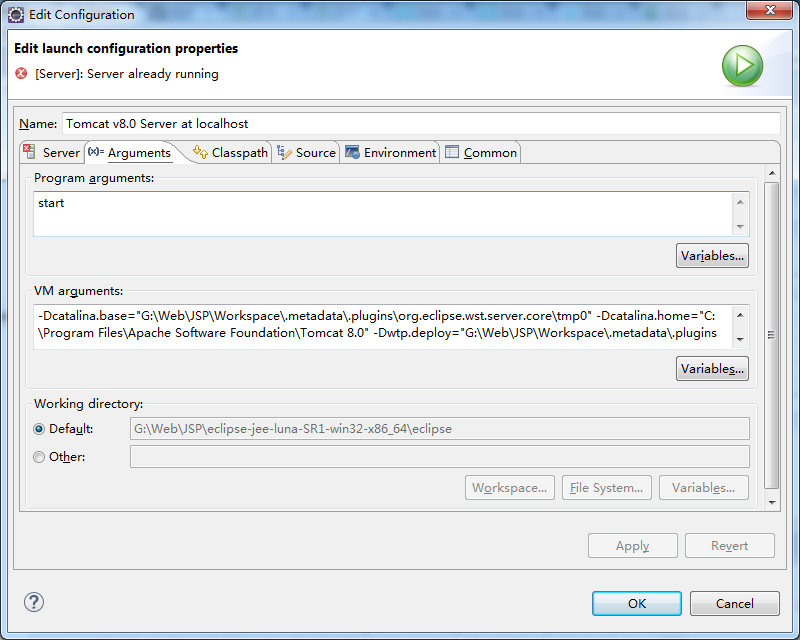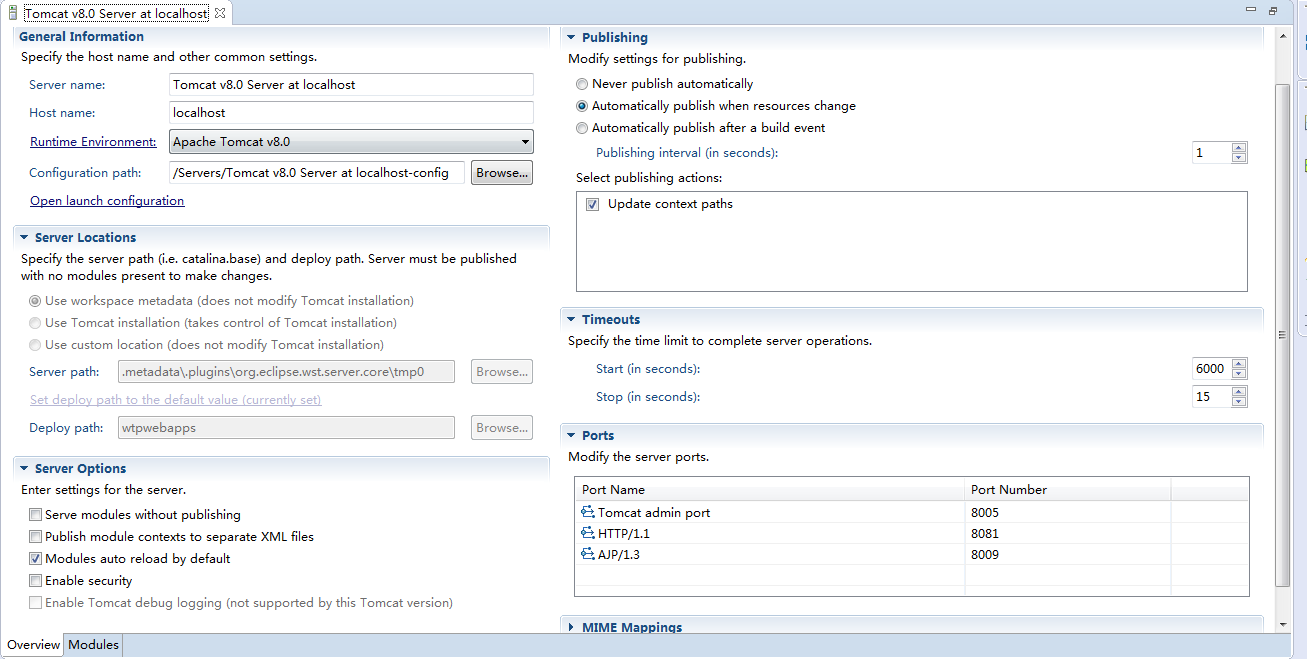Tomcat配置文件与启动顺序
三个配置应用的位置:
1、conf目录下的server.xml文件:此方式为Eclipse默认配置方法,同时也是三种方式中优先级最高的。
<?xml version="1.0" encoding="UTF-8"?>
<!--
Licensed to the Apache Software Foundation (ASF) under one or more
contributor license agreements. See the NOTICE file distributed with
this work for additional information regarding copyright ownership.
The ASF licenses this file to You under the Apache License, Version 2.0
(the "License"); you may not use this file except in compliance with
the License. You may obtain a copy of the License at http://www.apache.org/licenses/LICENSE-2.0 Unless required by applicable law or agreed to in writing, software
distributed under the License is distributed on an "AS IS" BASIS,
WITHOUT WARRANTIES OR CONDITIONS OF ANY KIND, either express or implied.
See the License for the specific language governing permissions and
limitations under the License.
--><!-- Note: A "Server" is not itself a "Container", so you may not
define subcomponents such as "Valves" at this level.
Documentation at /docs/config/server.html
--><Server port="8005" shutdown="SHUTDOWN">
<Listener className="org.apache.catalina.startup.VersionLoggerListener"/>
<!-- Security listener. Documentation at /docs/config/listeners.html
<Listener className="org.apache.catalina.security.SecurityListener" />
-->
<!--APR library loader. Documentation at /docs/apr.html -->
<Listener SSLEngine="on" className="org.apache.catalina.core.AprLifecycleListener"/>
<!-- Prevent memory leaks due to use of particular java/javax APIs-->
<Listener className="org.apache.catalina.core.JreMemoryLeakPreventionListener"/>
<Listener className="org.apache.catalina.mbeans.GlobalResourcesLifecycleListener"/>
<Listener className="org.apache.catalina.core.ThreadLocalLeakPreventionListener"/> <!-- Global JNDI resources
Documentation at /docs/jndi-resources-howto.html
-->
<GlobalNamingResources>
<!-- Editable user database that can also be used by
UserDatabaseRealm to authenticate users
-->
<Resource auth="Container" description="User database that can be updated and saved" factory="org.apache.catalina.users.MemoryUserDatabaseFactory" name="UserDatabase" pathname="conf/tomcat-users.xml" type="org.apache.catalina.UserDatabase"/>
</GlobalNamingResources> <!-- A "Service" is a collection of one or more "Connectors" that share
a single "Container" Note: A "Service" is not itself a "Container",
so you may not define subcomponents such as "Valves" at this level.
Documentation at /docs/config/service.html
-->
<Service name="Catalina"> <!--The connectors can use a shared executor, you can define one or more named thread pools-->
<!--
<Executor name="tomcatThreadPool" namePrefix="catalina-exec-"
maxThreads="150" minSpareThreads="4"/>
--> <!-- A "Connector" represents an endpoint by which requests are received
and responses are returned. Documentation at :
Java HTTP Connector: /docs/config/http.html (blocking & non-blocking)
Java AJP Connector: /docs/config/ajp.html
APR (HTTP/AJP) Connector: /docs/apr.html
Define a non-SSL HTTP/1.1 Connector on port 8080
-->
<Connector connectionTimeout="20000" port="8081" protocol="HTTP/1.1" redirectPort="8443"/>
<!-- A "Connector" using the shared thread pool-->
<!--
<Connector executor="tomcatThreadPool"
port="8080" protocol="HTTP/1.1"
connectionTimeout="20000"
redirectPort="8443" />
-->
<!-- Define a SSL HTTP/1.1 Connector on port 8443
This connector uses the NIO implementation that requires the JSSE
style configuration. When using the APR/native implementation, the
OpenSSL style configuration is required as described in the APR/native
documentation -->
<!--
<Connector port="8443" protocol="org.apache.coyote.http11.Http11NioProtocol"
maxThreads="150" SSLEnabled="true" scheme="https" secure="true"
clientAuth="false" sslProtocol="TLS" />
--> <!-- Define an AJP 1.3 Connector on port 8009 -->
<Connector port="8009" protocol="AJP/1.3" redirectPort="8443"/> <!-- An Engine represents the entry point (within Catalina) that processes
every request. The Engine implementation for Tomcat stand alone
analyzes the HTTP headers included with the request, and passes them
on to the appropriate Host (virtual host).
Documentation at /docs/config/engine.html --> <!-- You should set jvmRoute to support load-balancing via AJP ie :
<Engine name="Catalina" defaultHost="localhost" jvmRoute="jvm1">
-->
<Engine defaultHost="localhost" name="Catalina"> <!--For clustering, please take a look at documentation at:
/docs/cluster-howto.html (simple how to)
/docs/config/cluster.html (reference documentation) -->
<!--
<Cluster className="org.apache.catalina.ha.tcp.SimpleTcpCluster"/>
--> <!-- Use the LockOutRealm to prevent attempts to guess user passwords
via a brute-force attack -->
<Realm className="org.apache.catalina.realm.LockOutRealm">
<!-- This Realm uses the UserDatabase configured in the global JNDI
resources under the key "UserDatabase". Any edits
that are performed against this UserDatabase are immediately
available for use by the Realm. -->
<Realm className="org.apache.catalina.realm.UserDatabaseRealm" resourceName="UserDatabase"/>
</Realm> <Host appBase="webapps" autoDeploy="true" name="localhost" unpackWARs="true"> <!-- SingleSignOn valve, share authentication between web applications
Documentation at: /docs/config/valve.html -->
<!--
<Valve className="org.apache.catalina.authenticator.SingleSignOn" />
--> <!-- Access log processes all example.
Documentation at: /docs/config/valve.html
Note: The pattern used is equivalent to using pattern="common" -->
<Valve className="org.apache.catalina.valves.AccessLogValve" directory="logs" pattern="%h %l %u %t "%r" %s %b" prefix="localhost_access_log" suffix=".txt"/> <Context docBase="spring-websocket-portfolio" path="/spring-websocket-portfolio" reloadable="true" source="org.eclipse.jst.jee.server:spring-websocket-portfolio"/></Host>
</Engine>
</Service>
</Server>
多个应用时只需在最后的<Context>标签多写几个即可。docBase为发布目录,Eclipse默认为.metadata\.plugins\org.eclipse.wst.server.core\tmp0\wtpwebapps下,前提为该应用时Eclipse通过tomcat启动的。因为Eclipse里配置了tomcat的启动参数

-Dcatalina.base="G:\Web\JSP\Workspace\.metadata\.plugins\org.eclipse.wst.server.core\tmp0" -Dcatalina.home="C:\Program Files\Apache Software Foundation\Tomcat 8.0" -Dwtp.deploy="G:\Web\JSP\Workspace\.metadata\.plugins\org.eclipse.wst.server.core\tmp0\wtpwebapps" -Djava.endorsed.dirs="C:\Program Files\Apache Software Foundation\Tomcat 8.0\endorsed"
2、conf\Catalina\localhost目录下配置一个--目录名.xml文件,文件内容为
<Context docBase="test" path="/test" reloadable="true" />
这个path要和文件名一致,docBase为应用目录,默认在webapps目录下。
启动顺序比1低。
3、直接部署在默认的webapps目录下,tomcat会自动部署该项目。优先级最低。
扫描启动时在org.apache.catalina.startup.HostConfig类中的start()方法中,调用的
deployApps() 方法
protected void deployApps() {
File appBase = host.getAppBaseFile();
File configBase = host.getConfigBaseFile();
String[] filteredAppPaths = filterAppPaths(appBase.list());
// Deploy XML descriptors from configBase
deployDescriptors(configBase, configBase.list());
// Deploy WARs
deployWARs(appBase, filteredAppPaths);
// Deploy expanded folders
deployDirectories(appBase, filteredAppPaths);
}
其中,appBase为配置的默认部署目录,默认情况下为webapps目录
configBase为conf/Catalina/localhost目录,deployDescriptors方法:
/**
* Deploy XML context descriptors.
*/
protected void deployDescriptors(File configBase, String[] files) { if (files == null)
return; ExecutorService es = host.getStartStopExecutor();
List<Future<?>> results = new ArrayList<>(); for (int i = 0; i < files.length; i++) {
File contextXml = new File(configBase, files[i]); if (files[i].toLowerCase(Locale.ENGLISH).endsWith(".xml")) {
ContextName cn = new ContextName(files[i], true); if (isServiced(cn.getName()) || deploymentExists(cn.getName()))
continue; results.add(
es.submit(new DeployDescriptor(this, cn, contextXml)));
}
} for (Future<?> result : results) {
try {
result.get();
} catch (Exception e) {
log.error(sm.getString(
"hostConfig.deployDescriptor.threaded.error"), e);
}
}
}
取该文件夹下的所有xml文件,并取部署目录下同名文件夹,进行部署。最后才是部署默认目录的war包。

上图为Eclipse下tomcat的配置,General Information为通用信息,Runtime Environment可配置Java的环境等,OpenLaunchConfiguration为配置启动参数等,Configuration即tomcat的conf目录。
server locations为服务器文件放在何处,即配置文件,部署目录等放在哪里,只有移除全部module这里才可以做修改。
server options为服务器选项。第一个是不发布,即不放到target目录(?)。第二个为为每个应用发布到单独的xml文件,即localhost目录下。
第三个是默认重载模块,即做修改便重载。后略。
发布的一些选项,是否修改文件等等。超时选项,端口设置等等。
ps:配置session超时时间为:
1、修改server.xml下的应用配置:
<Context path="/test" docBase="/test"
defaultSessionTimeOut="3600" isWARExpanded="true"
isWARValidated="false" isInvokerEnabled="true"
isWorkDirPersistent="false"/>
2、web.xml下
<session-config>
<session-timeout>20</session-timeout>
</session-config>
3、
在程序中定义:
session.setMaxInactiveInterval(30*60);
设置单位为秒,设置为-1永不过期
不知道这种设置会不会真正地起到作用的哦!
session.setTimeout(你设置的时间); ------>>> 这个也可以,但是和setMaxInactiveInterval有什么差别暂时没有体会。
Tomcat配置文件与启动顺序的更多相关文章
- 使用spring等框架的web程序在Tomcat下的启动顺序及思路理清
大牛请绕过,此文仅针对自己小白水平,对web程序的启动流程做个清晰的回顾. 一.使用spring等框架的web程序在Tomcat下的启动流程 1)Tomcat是根据web.xml来启动的.首先到web ...
- [转] Linux环境变量配置文件以及启动顺序
转自:https://blog.csdn.net/bjnihao/article/details/51775854 一.环境变量配置文件: 对所有用户都起作用 /etc/profile /etc/pr ...
- spring框架等web程序在tomcat下的启动顺序
http://www.cnblogs.com/panxuejun/p/5847774.html
- 详解Tomcat 配置文件server.xml
前言 Tomcat隶属于Apache基金会,是开源的轻量级Web应用服务器,使用非常广泛.server.xml是Tomcat中最重要的配置文件,server.xml的每一个元素都对应了Tomcat中的 ...
- Tomcat 配置文件 server.xml
Tomcat隶属于Apache基金会,是开源的轻量级Web应用服务器,使用非常广泛.server.xml是Tomcat中最重要的配置文件,server.xml的每一个元素都对应了Tomcat中的一个组 ...
- Tomcat 配置文件server.xml详解
前言 Tomcat隶属于Apache基金会,是开源的轻量级Web应用服务器,使用非常广泛.server.xml是Tomcat中最重要的配置文件,server.xml的每一个元素都对应了Tomcat中的 ...
- Tomcat 配置文件
Tomcat 的配置文件并不多,由4个 xml 文件组成,分别是 context.xml.web.xml.server.xml.tomcat-users.xml 这几个文件.每个文件都有自己的功能与配 ...
- Tomcat配置文件server.xml(转)
前言 Tomcat隶属于Apache基金会,是开源的轻量级Web应用服务器,使用非常广泛.server.xml是Tomcat中最重要的配置文件,server.xml的每一个元素都对应了Tomcat中的 ...
- LINUX启动顺序
Linux 启动顺序: 1. BIOS自检 (服务器硬件启动的第一步,坑定的啦) 2. 运行系统内核并检测硬件(这个是看系统了,redhat等相关版本是通过/boot/vm进行启动 vmlinuz) ...
随机推荐
- Zookeeper的几个应用场景
场景一 有这样一个场景:系统中有大约100w的用户,每个用户平 均有3个邮箱账号,每隔5分钟,每个邮箱账需要收取100封邮件,最多3亿份邮件需要下载到服务器中(不含附件和正文).用20台机器划分计算的 ...
- 【转】javascript 执行环境,变量对象,作用域链
这篇文章比较清晰的解释了一些作用域链相关的概念,忍不住收藏了 原文地址:http://segmentfault.com/a/1190000000533094 前言 这几天在看<javascrip ...
- vue图片、背景图片路径问题
vue图片.背景图片路径问题 vue中引入图片经常会出现路径问题,在此记录一下: 1.组件中 <img> 引用图片 <img src="../assets/img/logo ...
- 运维自动化工具 Kickstart
简介: 批量安装操作系统工具之 Kickstart ,RedHat 早前推出的产品( 不多说了,现在都玩 Cobbler 啦 ). 测试环境:CentOS 6.6 x86_64 minimal 一.安 ...
- <转>linux操作系统编程——共享内存读写(采用信号量进行同步互斥)
http://blog.csdn.net/yanghaoran321/article/details/7872722 程序要求: 创建一个写端和一个读端,写端写入数据后读端才开始读,读端读完数据后,写 ...
- winfrom在图片上实现绘制
在控件加载入图片的基础上进行绘制内容 添加文字 首先就是要确定输入的文字,还有文字的样式. 文字的样式用到了FontDialog控件,获取文字呢,就放个textbox就可以了.如果在输入文字的显示展示 ...
- 我理解的MVCC内部实现原理
MySQL InnoDB存储引擎,实现的是基于多版本的并发控制协议——MVCC (Multi-Version Concurrency Control) (注:与MVCC相对的,是基于锁的并发控制,Lo ...
- centos 命令行和图形桌面模式的切换
1.安装系统时建议安装图形界面,毕竟图形桌面下安装程序,比较方便 2.系统部署完成后可以切换到命令行界面:打开一个SHELL窗口运行 init 3 即可进入命令行界面.恢复图形用init 5 3.进入 ...
- IIS网站最大并发连接数
打开网站服务器IIS---[控制面板]-[管理工具]--[Internet信息服务IIS管理器] 打开应用程序池--找到网站对应使用的应用程序池--选择右侧[高级设置] 在[高级设置]窗口可看 ...
- String.getBytes()[转]
在Java中,String的getBytes()方法是得到一个操作系统默认的编码格式的字节数组.这个表示在不通OS下,返回的东西不一样! String.getBytes(String decode)方 ...
